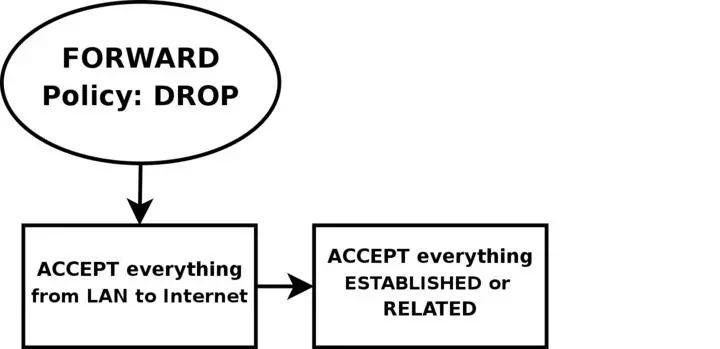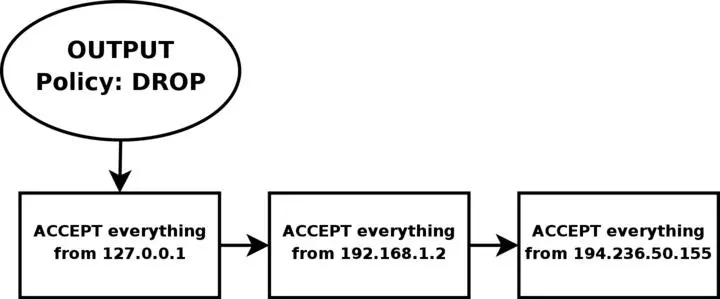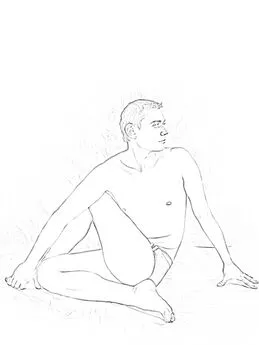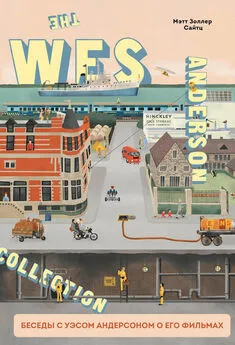Oskar Andreasson - Iptables Tutorial 1.2.2
- Название:Iptables Tutorial 1.2.2
- Автор:
- Жанр:
- Издательство:неизвестно
- Год:неизвестен
- ISBN:нет данных
- Рейтинг:
- Избранное:Добавить в избранное
-
Отзывы:
-
Ваша оценка:
Oskar Andreasson - Iptables Tutorial 1.2.2 краткое содержание
Iptables Tutorial 1.2.2 - читать онлайн бесплатно полную версию (весь текст целиком)
Интервал:
Закладка:
In the case of this scenario, we would also like to let our local network do connections to the Internet. Since the local network is fully trusted, we want to allow all kinds of traffic from the local network to the Internet. However, the Internet is most definitely not a trusted network and hence we want to block them from getting to our local network. Based upon these general assumptions, let's look at what we need to do and what we do not need and want to do.

First of all, we want the local network to be able to connect to the Internet, of course. To do this, we will need to SNAT all packets since none of the local computers have real IP addresses. All of this is done within the POSTROUTING chain, which is created last in this script. This means that we will also have to do some filtering within the FORWARD chain since we will otherwise allow outsiders full access to our local network. We trust our local network to the fullest, and because of that we specifically allow all traffic from our local network to the Internet. Since no one on the Internet should be allowed to contact our local network computers, we will want to block all traffic from the Internet to our local network except already established and related connections, which in turn will allow all return traffic from the Internet to our local network.

As for our firewall, we may be a bit low on funds perhaps, or we just want to offer a few services to people on the Internet. Therefore, we have decided to allow HTTP, FTP, SSH and IDENTD access to the actual firewall. All of these protocols are available on the actual firewall, and hence it should be allowed through the INPUT chain, and we need to allow the return traffic through the OUTPUT chain. However, we also trust the local network fully, and the loopback device and IP address are also trusted. Because of this, we want to add special rules to allow all traffic from the local network as well as the loopback network interface. Also, we do not want to allow specific packets or packet headers in specific conjunctions, nor do we want to allow some IP ranges to reach the firewall from the Internet. For instance, the 10.0.0.0/8 address range is reserved for local networks and hence we would normally not want to allow packets from such a address range since they would with 90% certainty be spoofed. However, before we implement this, we must note that certain Internet Service Providers actually use these address ranges within their own networks. For a closer discussion of this, read the Common problems and questions chapter.
Since we have an FTP server running on the server, as well as the fact we want to traverse as few rules as possible, we add a rule which lets all established and related traffic through at the top of the INPUT chain. For the same reason, we want to split the rules down into sub-chains. By doing this, our packets will hopefully only need to traverse as few rules as possible. By traversing less rules, we make the rule-set less time-consuming for each packet, and reduce latency within the network.
In this script, we choose to split the different packets down by their protocol family, for example TCP, UDP or ICMP. All TCP packets traverse a specific chain named tcp_packets, which will contain rules for all TCP ports and protocols that we want to allow. Also, we want to do some extra checking on the TCP packets, so we would like to create one more subchain for all packets that are accepted for using valid port numbers to the firewall. This chain we choose to call the allowed chain, and should contain a few extra checks before finally accepting the packet. As for ICMP packets, these will traverse the icmp_packets chain. When we decided on how to create this chain, we could not see any specific needs for extra checks before allowing the ICMP packets through if we agree with the type and code of the ICMP packet, and hence we accept them directly. Finally, we have the UDP packets which need to be dealt with. These packets, we send to the udp_packets chain which handles all incoming UDP packets. All incoming UDP packets should be sent to this chain, and if they are of an allowed type we should accept them immediately without any further checking.
Since we are running on a relatively small network, this box is also used as a secondary workstation and to give some extra leeway for this, we want to allow certain specific protocols to make contact with the firewall itself, such as speak freely and ICQ.

Finally, we have the firewalls OUTPUT chain. Since we actually trust the firewall quite a lot, we allow pretty much all traffic leaving the firewall. We do not do any specific user blocking, nor do we do any blocking of specific protocols. However, we do not want people to use this box to spoof packets leaving the firewall itself, and hence we only want to allow traffic from the IP addresses assigned to the firewall itself. We would most likely implement this by adding rules that ACCEPT all packets leaving the firewall in case they come from one of the IP addresses assigned to the firewall, and if not they will be dropped by the default policy in the OUTPUT chain.
Setting up default policies
Quite early on in the process of creating our rule-set, we set up the default policies. We set up the default policies on the different chains with a fairly simple command, as described below.
iptables [-P {chain} {policy}]
The default policy is used every time the packets do not match a rule in the chain. For example, let's say we get a packet that matches no single rule in our whole rule-set. If this happens, we must decide what should happen to the packet in question, and this is where the default policy comes into the picture. The default policy is used on all packets that does not match with any other rule in our rule-set.
Caution!Do be cautious with what default policy you set on chains in other tables since they are simply not made for filtering, and it may lead to very strange behaviors.
Setting up user specified chains in the filter table
Now you have a good picture of what we want to accomplish with this firewall, so let us get on to the actual implementation of the rule-set. It is now high time that we take care of setting up all the rules and chains that we wish to create and to use, as well as all of the rule-sets within the chains.
After this, we create the different special chains that we want to use with the -N command. The new chains are created and set up with no rules inside of them. The chains we will use are, as previously described, icmp_packets, tcp_packets, udp_packets and the allowed chain, which is used by the tcp_packets chain. Incoming packets on $INET_IFACE, of ICMP type, will be redirected to the chain icmp_packets. Packets of TCP type, will be redirected to the tcp_packets chain and incoming packets of UDP type from $INET_IFACE go to udp_packets chain. All of this will be explained more in detail in the INPUT chain section below. To create a chain is quite simple and only consists of a short declaration of the chain as this:
iptables [-N chain ]
In the upcoming sections we will have a closer look at each of the user defined chains that we have by now created. Let us have a closer look at how they look and what rules they contain and what we will accomplish within them.
The bad_tcp_packets chain
The bad_tcp_packets chain is devoted to contain rules that inspect incoming packets for malformed headers or other problems. As it is, we have only chosen to include a packet filter which blocks all incoming TCP packets that are considered as NEW but do not have the SYN bit set, as well as a rule that blocks SYN/ACK packets that are considered NEW. This chain could be used to check for all possible inconsistencies, such as above or XMAS port-scans etc. We could also add rules that looks for state INVALID.
If you want to fully understand the NEW not SYN, you need to look at the State NEW packets but no SYN bit set section in the Common problems and questions appendix regarding state NEW and non-SYN packets getting through other rules. These packets could be allowed under certain circumstances but in 99% of the cases we wouldn't want these packets to get through. Hence, we log them to our logs and then we DROP them.
The reason that we REJECT SYN/ACK packets that are considered NEW is also very simple. It is described in more depth in the SYN/ACK and NEW packets section in the Common problems and questions appendix. Basically, we do this out of courtesy to other hosts, since we will prevent them from being attacked in a sequence number prediction attack.
The allowed chain
If a packet comes in on $INET_IFACE and is of TCP type, it travels through the tcp_packets chain and if the connection is against a port that we want to allow traffic on, we want to do some final checks on it to see if we actually do want to allow it or not. All of these final checks are done within the allowed chain.
First of all, we check if the packet is a SYN packet. If it is a SYN packet, it is most likely to be the first packet in a new connection so, of course, we allow this. Then we check if the packet comes from an ESTABLISHED or RELATED connection, if it does, then we, again of course, allow it. An ESTABLISHED connection is a connection that has seen traffic in both directions, and since we have seen a SYN packet, the connection then must be in state ESTABLISHED, according to the state machine. The last rule in this chain will DROP everything else. In this case this pretty much means everything that has not seen traffic in both directions, i.e., we didn't reply to the SYN packet, or they are trying to start the connection with a non SYN packet. There is no practical use of not starting a connection with a SYN packet, except to port scan people pretty much. There is no currently available TCP/IP implementation that supports opening a TCP connection with something else than a SYN packet to my knowledge, hence, DROP it since it is 99% sure to be a port scan.
NoteThe rule regarding ESTABLISHED,RELATED packets is actually redundant in this script and will not be used, but has been included for the sake of being complete. The rule that will be used is placed at the top of the INPUT chain, and contains ESTABLISHED,RELATED as well.
The TCP chain
The tcp_packets chain specifies what ports are allowed to use on the firewall from the Internet. There is, however, even more checks to do, hence we send each and every one of the packets on to the allowed chain, which we described previously.
-A tcp_packets tells iptables in which chain to add the new rule, the rule will be added to the end of the chain. -p TCP tells it to match TCP packets and -s 0/0 matches all source addresses from 0.0.0.0 with netmask 0.0.0.0, in other words all source addresses. This is actually the default behavior but I am using it just to make everything as clear as possible. --dport 21 means destination port 21, in other words if the packet is destined for port 21 they also match. If all the criteria are matched, then the packet will be targeted for the allowed chain. If it doesn't match any of the rules, they will be passed back to the original chain that sent the packet to the tcp_packets chain.
Читать дальшеИнтервал:
Закладка:










